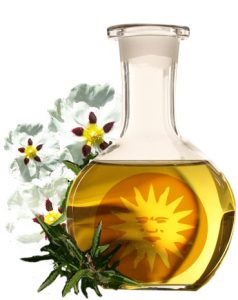Cistus Essential Oil (Cistus Ladaniferus)
At Esencias Lorente, we are proud to present our Cistus / Rockrose essential oil, a highly valued product in the aromatherapy, skincare, and perfumery sectors. Extracted from the resin of the Cistus ladanifer plant through a meticulous steam distillation process in stainless steel stills, our Cistus / Rockrose essential oil stands out for its unique chemical composition and properties. This essential oil is widely used in cosmetic and therapeutic products. Its warm, woody, and balsamic aroma makes it a popular choice in high-quality perfumery. At Esencias Lorente, we are committed to offering the highest quality in our products, providing our customers with a Cistus / Rockrose essential oil that meets the highest standards of purity and quality. Trust us to deliver a product that meets the technical demands of your industry.
Description: Clear liquid aspect essential oil yellow greenish coloured near to brown and soothing, woody and amber smell.
Bloom: This plant is completely wild and it grows in June.
Growth: For its essential use , it is produced in Huelva and to a lesser extent in Albacete.
Composition: It is composed of Alpha-Pinene, Camphene, Terpenine, Bornyl Acetate, etc.
Use: It is mostly used for perfumery industry.
TECHNICAL TABLE OF Cistus / Jara Essential Oil
ORGANOLEPTIC INFORMATION
PHYSICAL-CHEMICAL INFORMATION
CHEMICAL COMPOSITION (Active Principles)
The essential oil of cistus, also known as labdanum or rock rose essential oil, is extracted from the resin of the Cistus ladaniferus plant. This plant is renowned for its aromatic resin, which is used to produce the essential oil. Below are some of the common chemical components found in cistus essential oil:
- Alpha-pinene: A terpene commonly found in essential oils of various plants, known for its antimicrobial properties.
- Beta-caryophyllene: A sesquiterpene with anti-inflammatory and antioxidant properties.
- Borneol: Attributed with anti-inflammatory and analgesic properties.
- Nerol: A terpene alcohol contributing to the floral aroma and having relaxing properties.
- Eugenol: Present in smaller amounts, this compound has antiseptic and analgesic properties.
- Linalool: An alcohol that may have relaxing and anti-inflammatory properties.
- Ladic acid: Contributes to the aroma and may have antimicrobial properties.
The essential oil of cistus/labdanum is valued for its warm, woody, and balsamic aroma. It is used in aromatherapy, perfumery, and the cosmetic industry for its potential skin benefits and pleasant scent. It’s important to note that the exact composition may vary depending on factors such as the growing region, climatic conditions, and the method of oil extraction.
Description of Cistus – Labdanum:
Cistus, also known as labdanum, belongs to the genus Cistus and is a plant found in the Mediterranean region. The species Cistus ladaniferus is particularly prized for its resinous fragrance and potential benefits in aromatherapy.
- Appearance: Cistus is a perennial shrub that can grow up to 2 meters in height. Its leaves are grayish-green, lanceolate, and sticky to the touch due to the presence of resin.
- Flowers: The flowers of cistus are large and pure white, with a yellow center. They bloom in spring and summer.
- Resin: The plant produces a sticky resin called labdanum, which is found in the leaves and has been historically used in perfumery and in the production of some ointments and balms.
Uses and Applications of Cistus (Cistus ladaniferus):
- Aromatherapy: Cistus essential oil is extracted from the leaves and branches of the plant and is used in aromatherapy. It has a warm, woody, and resinous aroma that is considered relaxing and comforting. It is often used in essential oil blends to promote calmness and emotional balance.
- Skin Care: Labdanum resin has astringent and healing properties, so it is sometimes used in skincare products to tone and assist in skin regeneration.
- History: Throughout history, cistus resin has been used in perfumery and medicinal preparations. It is attributed with antimicrobial and anti-inflammatory properties and has been traditionally used to treat wounds and skin issues.
- Gardening: Cistus is also cultivated in ornamental gardens due to its beautiful flowers and aroma. It is a drought-resistant plant well-adapted to warm and dry climates.
It’s important to note that, while cistus and its labdanum resin have potential beneficial uses, caution is advised, and it’s recommended to consult with a professional before using them. Additionally, confirming the identification of the plant before use is crucial.
